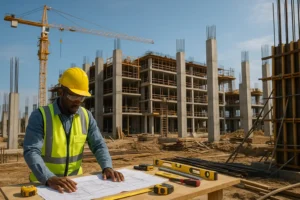
Step-by-Step Guide to Managing a Construction Project Efficiently
Introduction
Managing a construction project efficiently is critical for ensuring timely delivery, staying within budget, and achieving the desired quality standards. Construction projects often involve complex coordination of resources, labor, materials, and technology. Effective project management can be the difference between success and costly delays or mismanagement.
At BATIMOI BTP, we specialize in providing expert guidance and hands-on management for every phase of construction. This step-by-step guide will walk you through the best practices, strategies, and actionable steps to ensure your project is executed efficiently from planning to completion.
Step 1: Initial Planning and Feasibility Analysis
Understanding the Project Scope
Before starting any construction work, it is crucial to define the project scope clearly. This includes determining the size, type, and complexity of the building, along with desired outcomes. The scope sets the foundation for all future planning and resource allocation.
Conducting Feasibility Studies
Feasibility studies assess whether the project is viable in terms of budget, timeline, technical constraints, and regulations. This analysis helps identify potential risks and ensures the project aligns with financial and strategic objectives.
Setting Clear Objectives
Establish specific, measurable, achievable, realistic, and time-bound (SMART) goals for your project. Objectives provide clarity for the entire team and stakeholders, ensuring everyone understands the end vision.
Step 2: Budgeting and Cost Estimation
Developing a Detailed Budget
Accurate budgeting is essential to avoid unexpected financial pitfalls. Break down costs for materials, labor, equipment, permits, and contingency funds.
Cost Control Measures
Implement systems to monitor expenses in real time. Track deviations from the initial budget and adjust plans to prevent cost overruns.
Engaging a Financial Advisor
For large-scale projects, hiring an experienced construction financial advisor can help optimize cost efficiency while maintaining quality standards.
Step 3: Project Scheduling and Timeline Management
Creating a Realistic Timeline
A well-structured schedule ensures tasks are completed in order and resources are optimally allocated. Divide the project into phases, such as planning, foundation, structural, finishing, and inspection.
Using Project Management Software
Modern tools like MS Project, Primavera, or specialized construction management software help track tasks, deadlines, and dependencies efficiently.
Milestone Planning
Set key milestones to monitor progress. These could include completion of foundation, roofing, interior work, and final inspection. Milestones serve as checkpoints to ensure the project is on track.
Step 4: Resource Management
Labor Allocation
Assign skilled professionals for specific tasks. Ensure workers understand their responsibilities and have access to the required tools and materials.
Material Procurement
Procure high-quality materials on time to avoid delays. Establish relationships with reliable suppliers to ensure consistent delivery.
Equipment Management
Ensure machinery and equipment are maintained, available, and suitable for the tasks. This prevents downtime and operational bottlenecks.
Step 5: Communication and Collaboration
Regular Team Meetings
Hold weekly or bi-weekly meetings to discuss progress, challenges, and upcoming tasks. This promotes transparency and accountability.
Stakeholder Updates
Keep clients and stakeholders informed through reports, emails, or dashboards. Clear communication builds trust and ensures everyone is aligned.
Using Collaboration Tools
Cloud-based platforms enable teams to share plans, blueprints, and updates in real time, minimizing misunderstandings and mistakes.
Step 6: Quality Assurance and Risk Management
Implementing Quality Control Measures
Regular inspections and checks ensure the construction meets the required standards and regulations. Employ certified inspectors and quality control officers to monitor progress.
Identifying and Mitigating Risks
Every construction project comes with risks—delays, budget overruns, accidents, or material shortages. Develop a risk management plan to address issues promptly.
Adapting to Changes
Construction projects may require adjustments due to unforeseen conditions. Efficient project managers adapt schedules, resources, and strategies without compromising quality.
Step 7: Health, Safety, and Compliance
Adhering to Safety Regulations
Ensure all safety protocols are strictly followed, including the use of personal protective equipment (PPE), safety signs, and emergency procedures.
Training and Awareness
Provide continuous safety training to workers and supervisors. Awareness reduces accidents and promotes a safe working environment.
Regulatory Compliance
Obtain all necessary permits and ensure the project adheres to local building codes and environmental regulations.
Step 8: Monitoring and Progress Reporting
Tracking Key Performance Indicators (KPIs)
Monitor KPIs such as cost variance, schedule adherence, and quality metrics. This data-driven approach ensures timely interventions.
Progress Reports
Prepare regular progress reports for internal and client review. Highlight completed milestones, upcoming tasks, and any challenges encountered.
Using Dashboards
Digital dashboards provide a visual representation of the project’s status, helping managers make informed decisions quickly.
Step 9: Final Inspection and Project Handover
Conducting a Thorough Final Inspection
Before handing over the project, inspect all aspects of the construction. Check for defects, incomplete work, or deviations from the plan.
Client Walkthrough
Guide the client through the completed project. Explain the features, operations, and maintenance requirements.
Handover Documentation
Provide comprehensive documentation, including blueprints, warranties, manuals, and compliance certificates. Proper documentation ensures smooth post-construction management.
Step 10: Post-Project Review and Feedback
Evaluating Project Performance
Review project execution against initial objectives. Assess what worked well and areas that need improvement.
Collecting Client Feedback
Client satisfaction is crucial. Gather feedback to improve future project management practices and maintain strong client relationships.
Continuous Improvement
Use insights gained from this project to refine processes, enhance efficiency, and deliver even better results in future projects.
Conclusion
Efficient construction project management combines planning, budgeting, scheduling, resource allocation, communication, quality control, and safety. Following these steps ensures timely delivery, cost control, and client satisfaction.
For expert guidance and hands-on construction management, contact BATIMOI BTP today. Email us at info@batimoibtp.com or reach out via our contact page to get started on your next project.

